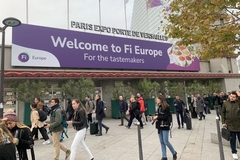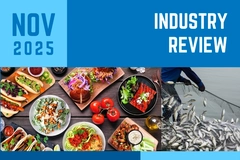
- Industry news
Industry news
- Category news
Category news
- Reports
- Key trends
- Multimedia
Multimedia
- Journal
- Events
- Suppliers
Suppliers
- Home
- Industry news
Industry news
- Category news
Category news
- Reports
- Key trends
- Multimedia
Multimedia
- Events
- Suppliers
Suppliers
Givaudan exec spotlights “holistic growth” of alternative protein development as new European hub opens

07 Sep 2021 --- Givaudan has expanded its global protein innovation network with a new Protein Hub at its flagship Zurich Innovation Centre (ZIC) in Kemptthal, Switzerland. Speaking exclusively to FoodIngredientsFirst, Thomas Ullram, innovation director savory Europe, Givaudan Taste & Wellbeing Division, explains how the Swiss flavor giant is driving the development of meat and fish alternatives from a holistic perspective.
According to Ullram, the company is not focused on specific alternative proteins. He says that the nature of the hub is “to stay as flexible and agile as possible.”
“We’re always thinking about the holistic design of a product,” he outlines. “And by doing so, we look at the whole alternative protein space as a customer journey.”

Equipped with a state-of-the-art development kitchen and a pilot plant that includes a new high moisture extrusion machine, the Protein Hub will build on Givaudan’s expertise in taste, texture, colors, proteins and ingredients.
.jpg) The Protein Hub is an integral part of Givaudan’s global protein innovation network.Customers can come to the Hub to work on all types of applications and every aspect of the product development process, from initial ideation and consumer insights to hands-on prototyping sessions – all to get products to market quickly.
The Protein Hub is an integral part of Givaudan’s global protein innovation network.Customers can come to the Hub to work on all types of applications and every aspect of the product development process, from initial ideation and consumer insights to hands-on prototyping sessions – all to get products to market quickly.
Trends in alternative proteins
Ullram stresses that trends in the alternative proteins space are “evolving rapidly.”
Givaudan’s goal is to create “something really beautiful,” which might be a fillet mignon or a fish alternative, he exemplifies. “Whatever the challenge is, it’s up to our experts in the hub to identify a solution after breaking down ingredients and seeing which ones work best together.”
“We have seen the development of fava beans, chickpeas and mung beans emerge. We’ve also witnessed insect protein, potato protein and even air,” he explains.
Ultimately, Givaudan intends to branch out from standard protein varieties in addressing customer needs. “It’s rather giving a proper consultation on what it is that they want to achieve in a product from a nutritional and sustainability perspective, and find the best protein which fits those needs,” Ullram notes.
Focus on meat and fish alternatives
Givaudan’s focus at the Protein Hub will primarily be on meat and fish analogs. According to Ullram, this is “where the magic happens” in terms of technology.
“We have our high moisture extrusion machine, which is a completely new setup, so that’s the technological heart of the story. It enables our customers and us to talk about a new structure of products, with more fibers and improved fibrosis structures – which was not possible with a dry extrusion process.” Thomas Ullram, innovation director savory Europe, Givaudan Taste & Wellbeing Division, highlights the importance of meat alternatives.
Thomas Ullram, innovation director savory Europe, Givaudan Taste & Wellbeing Division, highlights the importance of meat alternatives.
It is also possible to produce much larger pieces of protein, he adds. “So we are talking about fillets, not only small chunks, which we don’t see a real need for right now,” he comments.
“From a flavor and taste perspective, we can play with many more stages along the production process of flavors.”
He asserts that there are many opportunities in flavors for seafood analogs.
According to Ullram, it is possible to adjust the flavor with the right dosage, but you need to bring it in using the right dosage, especially with the extrusion process. “Flavors can be destroyed very quickly, particularly in heat and high pressure,” he adds.
Hybrid potential?
Industry is no stranger to merging meat and vegetable proteins. From a technological perspective, Ullram says hybrid innovation is “easier to reach” in terms of mimicking meat.
“You already have a certain amount of meat in there, so you don’t need to build a whole new product,” he remarks.
“I think it’s all about customer acceptance and whether it is working or not,” he notes. “What we’ve seen so far is that there are two streams of consumers seeing hybrids. One stream is ‘the best of the two worlds,’ where consumers view hybrids as marginally sustainable and delicious.”
“We also have consumers who say meat and plant hybrids are absolutely not sustainable because they still contain meat and will not be tasty because they are partly plant-based. So these are the two extremes.”
Recent analysis by Dutch research organization CE Delft has found that hybrid products combining plant-based meats with cultivated meat may offer a “compelling near-term opportunity” to further reduce costs and hit environmental targets, while more thoroughly biomimicking the meat-eating experience.
 Many consumers are shifting to plant-based options and other alternatives for health and ethical reasons.
Many consumers are shifting to plant-based options and other alternatives for health and ethical reasons.
In this space, Planteneers developed new solutions for hybrid plant and animal products last month, appealing to flexitarians.
Echoing the success of this trend, Matrix Meats’ CEO Eric Jenkusky predicted in a recent interview with FoodIngredientsFirst that plant- and cell-based hybrids are set to take over the alternative meat revolution.
Location fit for innovation
The opening of the ZIC Protein Hub follows the launch of Givaudan’s APAC Protein Innovation Centre in Singapore in April.
“We have several partners we work closely with, such as UC Berkeley, to stay ahead of what’s happening in the ingredient and technology space,” says Ullram. “The beauty of the new hub is to have everything under one roof, which offers so much inspiration and access to technologies.”
“There is an abundance of creative flow and inspiration. It’s a great atmosphere, and we have access to our savory pilot plants. For us, there is no better place to focus on plant-based production.”
By Elizabeth Green











